display YAMAHA TRACER 900 GT 2021 User Guide
[x] Cancel search | Manufacturer: YAMAHA, Model Year: 2021, Model line: TRACER 900 GT, Model: YAMAHA TRACER 900 GT 2021Pages: 116, PDF Size: 4.35 MB
Page 34 of 116
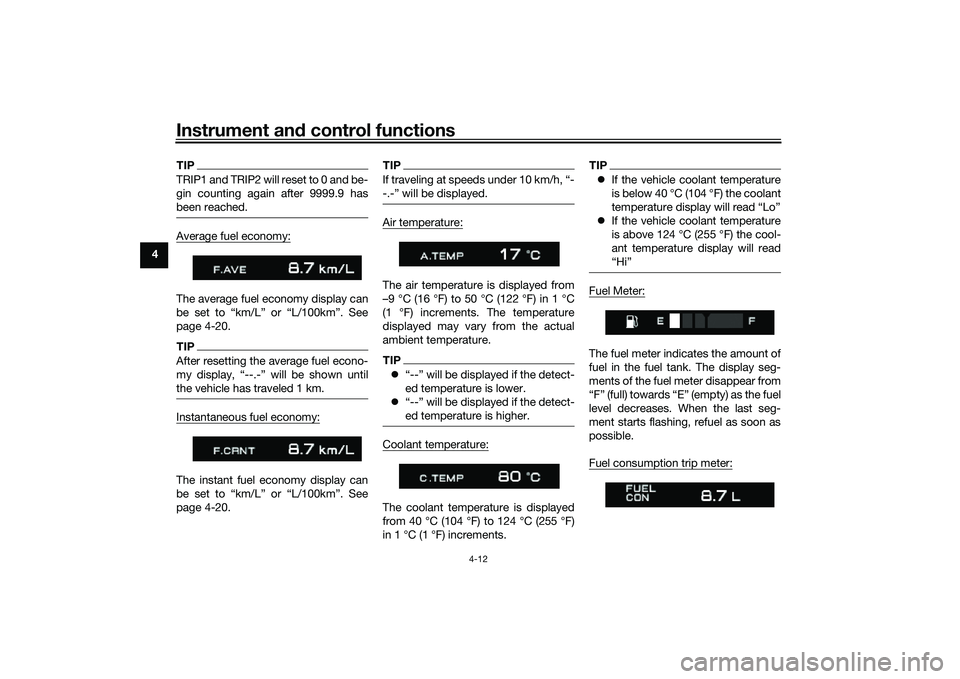
Instrument and control functions
4-12
4
TIPTRIP1 and TRIP2 will reset to 0 and be-
gin counting again after 9999.9 has
been reached.Average fuel economy:The average fuel economy display can
be set to “km/L” or “L/100km”. See
page 4-20.TIPAfter resetting the average fuel econo-
the vehicle has traveled 1 km.Instantaneous fuel economy:The instant fuel economy display can
page 4-20.
TIP
-.-Ž will be displayed.Air temperature:The air temperature is displayed from
…9 °C (16 °F) to 50 °C (122 °F) in 1 °C
(1 °F) increments. The temperature
displayed may vary from the actual
ambient temperature.TIP “--” will be displayed if the detect-
ed temperature is lower.
“--” will be displayed if the detect-
ed temperature is higher.Coolant temperature:The coolant temperature is displayed
from 40 °C (104 °F) to 124 °C (255 °F)
in 1 °C (1 °F) increments.
TIPIf the vehicle coolant temperature
is below 40 °C (104 °F) the coolant
temperature display will read “Lo”
If the vehicle coolant temperature
is above 124 °C (255 °F) the cool-
ant temperature display will read
“Hi”Fuel Meter:The fuel meter indicates the amount of
fuel in the fuel tank. The display seg-
ments of the fuel meter disappear from
“F” (full) towards “E” (empty) as the fuel
level decreases. When the last seg-
ment starts flashing, refuel as soon as
possible.
Fuel consumption trip meter:
UBAPE0E0.book Page 12 Thursday, December 24, 2020 9:14 AM
Page 35 of 116
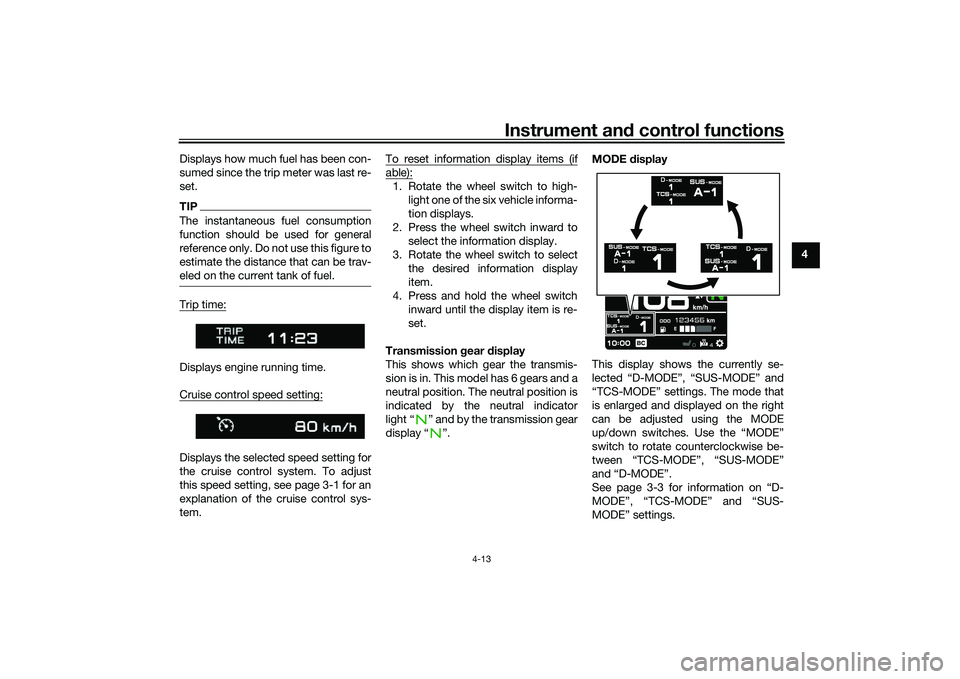
Instrument and control functions
4-13
4
Displays how much fuel has been con-
sumed since the trip meter was last re-
set.
TIPThe instantaneous fuel consumption
function should be used for general
reference only. Do not use this figure to
estimate the distance that can be trav-
eled on the current tank of fuel.Trip time:Displays engine running time.
Cruise control speed setting:Displays the selected speed setting for
the cruise control system. To adjust
this speed setting, see page 3-1 for an
explanation of the cruise control sys-
tem. To reset information display items (if
able):1. Rotate the wheel switch to high-
light one of the six vehicle informa-
tion displays.
2. Press the wheel switch inward to select the information display.
3. Rotate the wheel switch to select the desired information display
item.
4. Press and hold the wheel switch inward until the display item is re-
set.
Transmission gear display
This shows which gear the transmis-
sion is in. This model has 6 gears and a
neutral position. The neutral position is
indicated by the neutral indicator
light “ ” and by the transmission gear
display “ ”. MODE
display
This display shows the currently se-
lected “D-MODE”, “SUS-MODE” and
“TCS-MODE” settings. The mode that
is enlarged and displayed on the right
can be adjusted using the MODE
up/down switches. Use the “MODE”
switch to rotate counterclockwise be-
tween “TCS-MODE”, “SUS-MODE”
and “D-MODE”.
See page 3-3 for information on “D-
MODE”, “TCS-MODE” and “SUS-
MODE” settings.
UBAPE0E0.book Page 13 Thursday, December 24, 2020 9:14 AM
Page 36 of 116
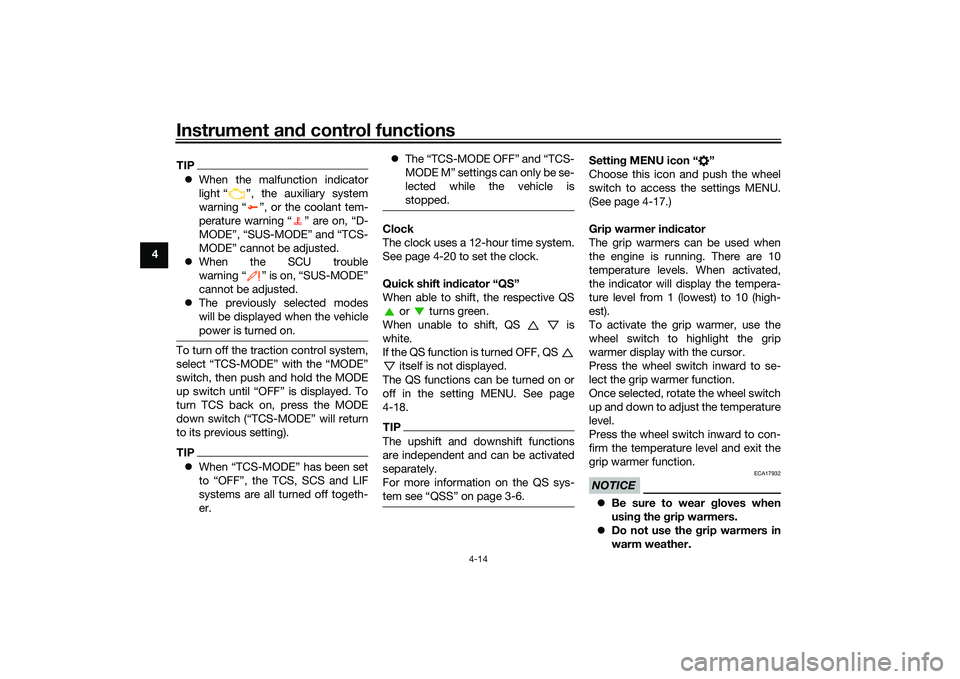
Instrument and control functions
4-14
4
TIP When the malfunction indicator
light “ ”, the auxiliary system
warning “ ”, or the coolant tem-
perature warning “ ” are on, “D-
MODE”, “SUS-MODE” and “TCS-
MODE” cannot be adjusted.
When the SCU trouble
warning “ ” is on, “SUS-MODE”
cannot be adjusted.
The previously selected modes
will be displayed when the vehicle
power is turned on.To turn off the traction control system,
select “TCS-MODE” with the “MODE”
switch, then push and hold the MODE
up switch until “OFF” is displayed. To
turn TCS back on, press the MODE
down switch (“TCS-MODE” will return
to its previous setting).TIPWhen “TCS-MODE” has been set
to “OFF”, the TCS, SCS and LIF
systems are all turned off togeth-
er.
The “TCS-MODE OFF” and “TCS-
MODE M” settings can only be se-
lected while the vehicle is
stopped.
Clock
The clock uses a 12-hour time system.
See page 4-20 to set the clock.
Quick shift in dicator “QS”
When able to shift, the respective QS or turns green.
When unable to shift, QS is
white.
If the QS function is turned OFF, QS itself is not displayed.
The QS functions can be turned on or
off in the setting MENU. See page
4-18.TIPThe upshift and downshift functions
are independent and can be activated
separately.
For more information on the QS sys-
Settin g MENU icon “ ”
Choose this icon and push the wheel
switch to access the settings MENU.
(See page 4-17.)
Grip warmer in dicator
The grip warmers can be used when
the engine is running. There are 10
temperature levels. When activated,
the indicator will display the tempera-
ture level from 1 (lowest) to 10 (high-
est).
To activate the grip warmer, use the
wheel switch to highlight the grip
warmer display with the cursor.
Press the wheel switch inward to se-
lect the grip warmer function.
Once selected, rotate the wheel switch
up and down to adjust the temperature
level.
Press the wheel switch inward to con-
firm the temperature level and exit the
grip warmer function.NOTICE
ECA17932
Be sure to wear gloves when
usin g the g rip warmers.
Do not use the grip warmers in
warm weather.
UBAPE0E0.book Page 14 Thursday, December 24, 2020 9:14 AM
Page 37 of 116
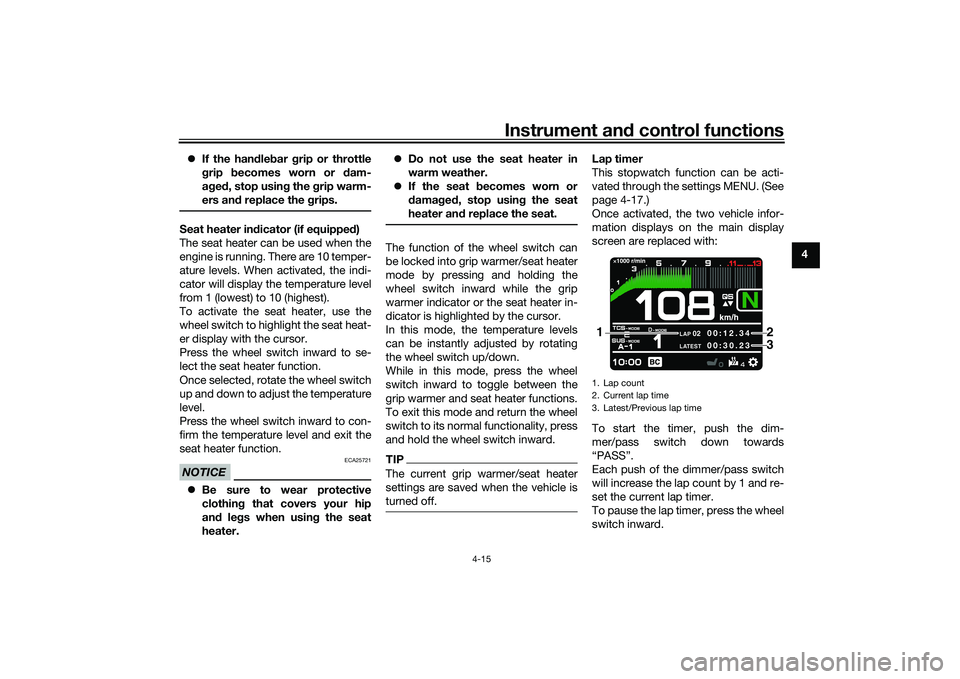
Instrument and control functions
4-15
4
If the han dle bar grip or throttle
g rip becomes worn or dam-
a g ed , stop usin g the g rip warm-
ers an d replace the grips.
Seat heater in dicator (if equipped )
The seat heater can be used when the
engine is running. There are 10 temper-
ature levels. When activated, the indi-
cator will display the temperature level
from 1 (lowest) to 10 (highest).
To activate the seat heater, use the
wheel switch to highlight the seat heat-
er display with the cursor.
Press the wheel switch inward to se-
lect the seat heater function.
Once selected, rotate the wheel switch
up and down to adjust the temperature
level.
Press the wheel switch inward to con-
firm the temperature level and exit the
seat heater function.NOTICE
ECA25721
Be sure to wear protective
clothin g that covers your hip
an d le gs when usin g the seat
heater.
Do not use the seat heater in
warm weather.
If the seat b ecomes worn or
d amag ed , stop usin g the seat
heater an d replace the seat.
The function of the wheel switch can
be locked into grip warmer/seat heater
mode by pressing and holding the
wheel switch inward while the grip
warmer indicator or the seat heater in-
dicator is highlighted by the cursor.
In this mode, the temperature levels
can be instantly adjusted by rotating
the wheel switch up/down.
While in this mode, press the wheel
switch inward to toggle between the
grip warmer and seat heater functions.
To exit this mode and return the wheel
switch to its normal functionality, press
and hold the wheel switch inward.TIPThe current grip warmer/seat heater
settings are saved when the vehicle is
turned off.
Lap timer
This stopwatch function can be acti-
vated through the settings MENU. (See
page 4-17.)
Once activated, the two vehicle infor-
mation displays on the main display
screen are replaced with:
To start the timer, push the dim-
mer/pass switch down towards
“PASS”.
Each push of the dimmer/pass switch
will increase the lap count by 1 and re-
set the current lap timer.
To pause the lap timer, press the wheel
switch inward.1. Lap count
2. Current lap time
3. Latest/Previous lap time
LAP
02
LATEST
00:12.3 4
00:3 0.23
2
1
3
UBAPE0E0.book Page 15 Thursday, December 24, 2020 9:14 AM
Page 38 of 116
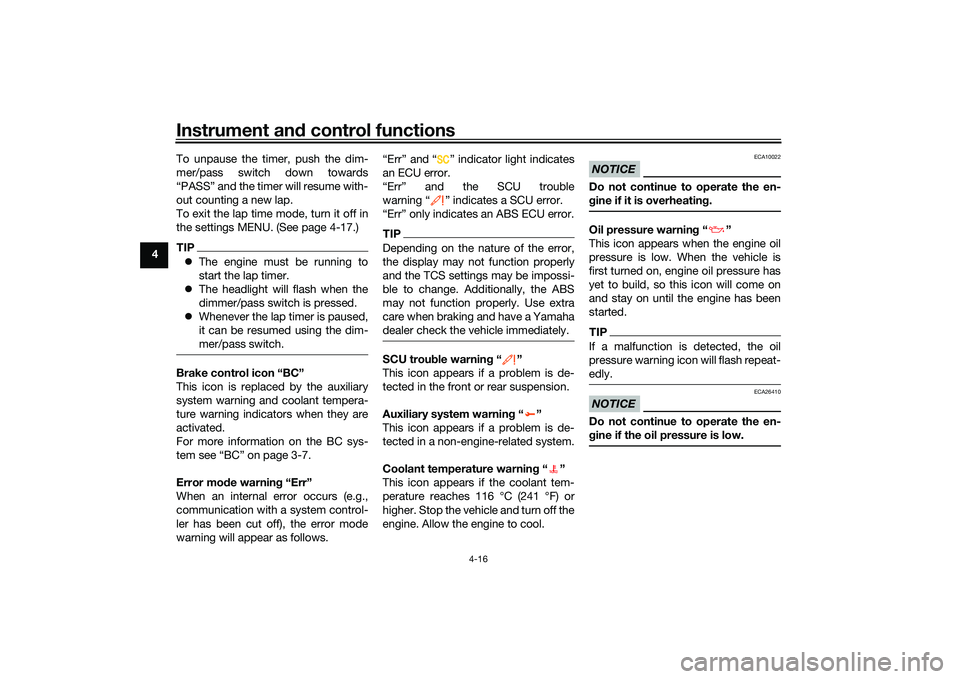
Instrument and control functions
4-16
4 To unpause the timer, push the dim-
mer/pass switch down towards
“PASS” and the timer will resume with-
out counting a new lap.
To exit the lap time mode, turn it off in
the settings MENU. (See page 4-17.)
TIP
The engine must be running to
start the lap timer.
The headlight will flash when the
dimmer/pass switch is pressed.
Whenever the lap timer is paused,
it can be resumed using the dim-
mer/pass switch.Brake control icon “BC”
This icon is replaced by the auxiliary
system warning and coolant tempera-
ture warning indicators when they are
activated.
For more information on the BC sys-
tem see “BC” on page 3-7.
Error mo de warnin g “Err”
When an internal error occurs (e.g.,
communication with a system control-
ler has been cut off), the error mode
warning will appear as follows. “Err” and “ ” indicator light indicates
an ECU error.
“Err” and the SCU trouble
warning “ ” indicates a SCU error.
“Err” only indicates an ABS ECU error.
TIPDepending on the nature of the error,
the display may not function properly
and the TCS settings may be impossi-
ble to change. Additionally, the ABS
may not function properly. Use extra
care when braking and have a Yamaha
dealer check the vehicle immediately.SCU trou
ble warnin g“”
This icon appears if a problem is de-
tected in the front or rear suspension.
Auxiliary system warnin g“”
This icon appears if a problem is de-
tected in a non-engine-related system.
Coolant temperature warnin g“”
This icon appears if the coolant tem-
perature reaches 116 °C (241 °F) or
higher. Stop the vehicle and turn off the
engine. Allow the engine to cool.
NOTICE
ECA10022
Do not continue to operate the en-
g ine if it is overheatin g.Oil pressure warnin g“”
This icon appears when the engine oil
pressure is low. When the vehicle is
first turned on, engine oil pressure has
yet to build, so this icon will come on
and stay on until the engine has been
started.TIPIf a malfunction is detected, the oil
pressure warning icon will flash repeat-
edly.NOTICE
ECA26410
Do not continue to operate the en-
g ine if the oil pressure is low.
UBAPE0E0.book Page 16 Thursday, December 24, 2020 9:14 AM
Page 39 of 116
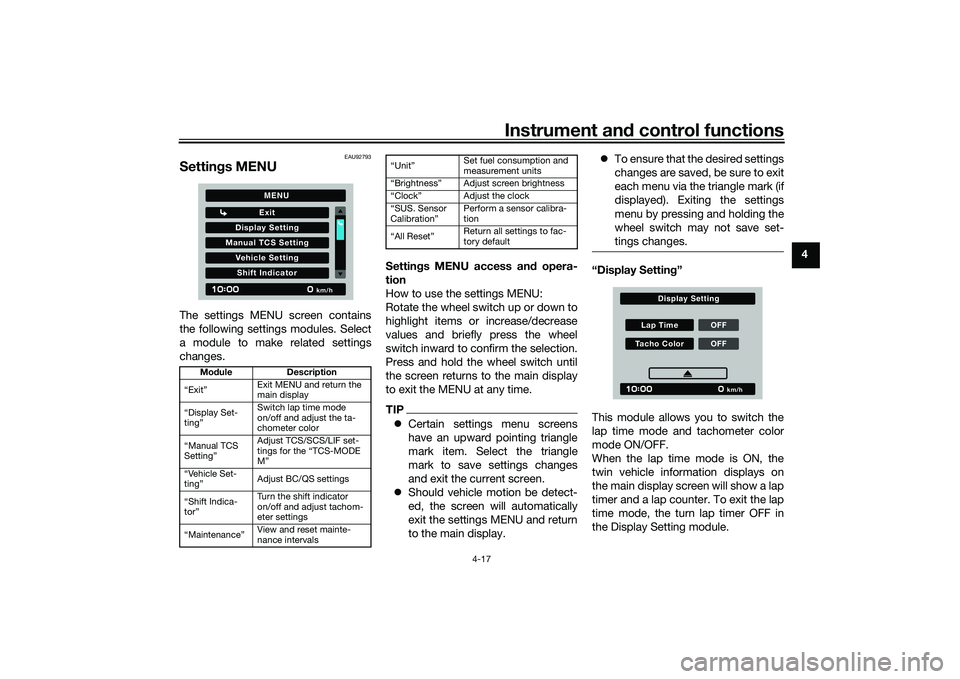
Instrument and control functions
4-17
4
EAU92793
Settin gs MENUThe settings MENU screen contains
the following settings modules. Select
a module to make related settings
changes. Settin
gs MENU access an d opera-
tion
How to use the settings MENU:
Rotate the wheel switch up or down to
highlight items or increase/decrease
values and briefly press the wheel
switch inward to confirm the selection.
Press and hold the wheel switch until
the screen returns to the main display
to exit the MENU at any time.
TIP Certain settings menu screens
have an upward pointing triangle
mark item. Select the triangle
mark to save settings changes
and exit the current screen.
Should vehicle motion be detect-
ed, the screen will automatically
exit the settings MENU and return
to the main display.
To ensure that the desired settings
changes are saved, be sure to exit
each menu via the triangle mark (if
displayed). Exiting the settings
menu by pressing and holding the
wheel switch may not save set-
tings changes.
“Display Settin g”
This module allows you to switch the
lap time mode and tachometer color
mode ON/OFF.
When the lap time mode is ON, the
twin vehicle information displays on
the main display screen will show a lap
timer and a lap counter. To exit the lap
time mode, the turn lap timer OFF in
the Display Setting module.
Mo dule Description
“Exit” Exit MENU and return the
main display
“Display Set-
ting” Switch lap time mode
on/off and adjust the ta-
chometer color
“Manual TCS
Setting” Adjust TCS/SCS/LIF set-
tings for the “TCS-MODE
M”
“Vehicle Set-
ting” Adjust BC/QS settings
“Shift Indica-
tor” Turn the shift indicator
on/off and adjust tachom-
eter settings
“Maintenance” View and reset mainte-
nance intervals
Display S
etting
Exit
Manual TCS S ettingVehicle S ettingShift Indicator
km/h
MENU
Set fuel consumption and
measurement units
Adjust screen brightness
Adjust the clock
CalibrationŽ Perform a sensor calibra-
tion
Return all settings to fac-
tory default
Lap Time OFFTacho Color OFF
km/h
Display Setting
UBAPE0E0.book Page 17 Thursday, December 24, 2020 9:14 AM
Page 40 of 116
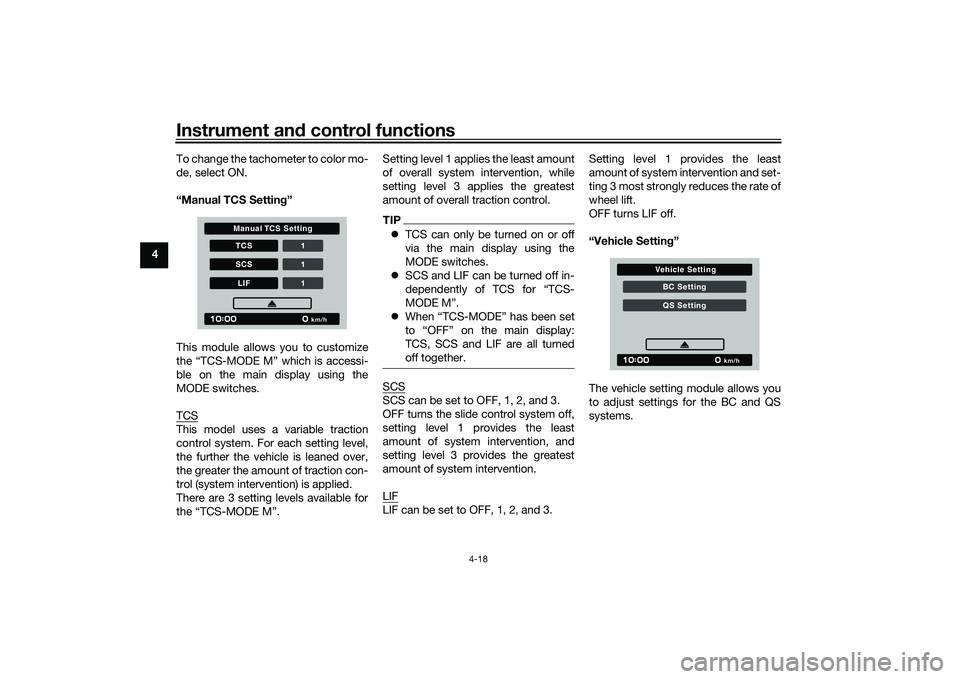
Instrument and control functions
4-18
4 To change the tachometer to color mo-
de, select ON.
“Manual TCS Settin
g”
This module allows you to customize
the “TCS-MODE M” which is accessi-
ble on the main display using the
MODE switches.
TCS
This model uses a variable traction
control system. For each setting level,
the further the vehicle is leaned over,
the greater the amount of traction con-
trol (system intervention) is applied.
There are 3 setting levels available for
the “TCS-MODE M”. Setting level 1 applies the least amount
of overall system intervention, while
setting level 3 applies the greatest
amount of overall traction control.
TIP
TCS can only be turned on or off
via the main display using the
MODE switches.
SCS and LIF can be turned off in-
dependently of TCS for “TCS-
MODE M”.
When “TCS-MODE” has been set
to “OFF” on the main display:
TCS, SCS and LIF are all turned
off together.SCSSCS can be set to OFF, 1, 2, and 3.
OFF turns the slide control system off,
setting level 1 provides the least
amount of system intervention, and
setting level 3 provides the greatest
amount of system intervention.
LIFLIF can be set to OFF, 1, 2, and 3. Setting level 1 provides the least
amount of system intervention and set-
ting 3 most strongly reduces the rate of
wheel lift.
OFF turns LIF off.
“Vehicle Setting
”
The vehicle setting module allows you
to adjust settings for the BC and QS
systems.
TCS 1SC S 1LIF 1
km/h
Manual TCS Setting
BC SettingQS S etting
km/h
Vehicle Setting
UBAPE0E0.book Page 18 Thursday, December 24, 2020 9:14 AM
Page 42 of 116
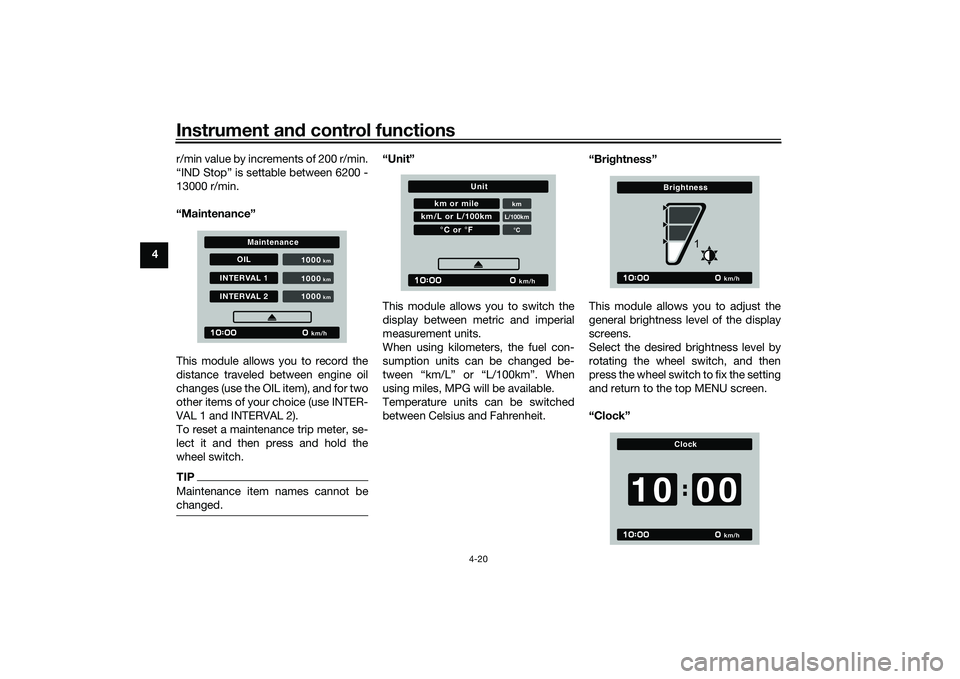
Instrument and control functions
4-20
4 r/min value by increments of 200 r/min.
“IND Stop” is settable between 6200 -
13000 r/min.
“Maintenance”
This module allows you to record the
distance traveled between engine oil
changes (use the OIL item), and for two
other items of your choice (use INTER-
VAL 1 and INTERVAL 2).
To reset a maintenance trip meter, se-
lect it and then press and hold the
wheel switch.
TIPMaintenance item names cannot be
changed.
“Unit”
This module allows you to switch the
display between metric and imperial
measurement units.
When using kilometers, the fuel con-
sumption units can be changed be-
tween “km/L” or “L/100km”. When
using miles, MPG will be available.
Temperature units can be switched
between Celsius and Fahrenheit. “Brig
htness”
This module allows you to adjust the
general brightness level of the display
screens.
Select the desired brightness level by
rotating the wheel switch, and then
press the wheel switch to fix the setting
and return to the top MENU screen.
“Clock”
OIL
INTERVAL 1INTERVAL 2 1000
km/h
km
1000
km
1000
km
Maintenance
km or mile
kmL/100km°C
km/L or L/100km
°C or °F
km/h
Unit
km/h
Brightness
1
km/h
Clock
0010
UBAPE0E0.book Page 20 Thursday, December 24, 2020 9:14 AM
Page 43 of 116
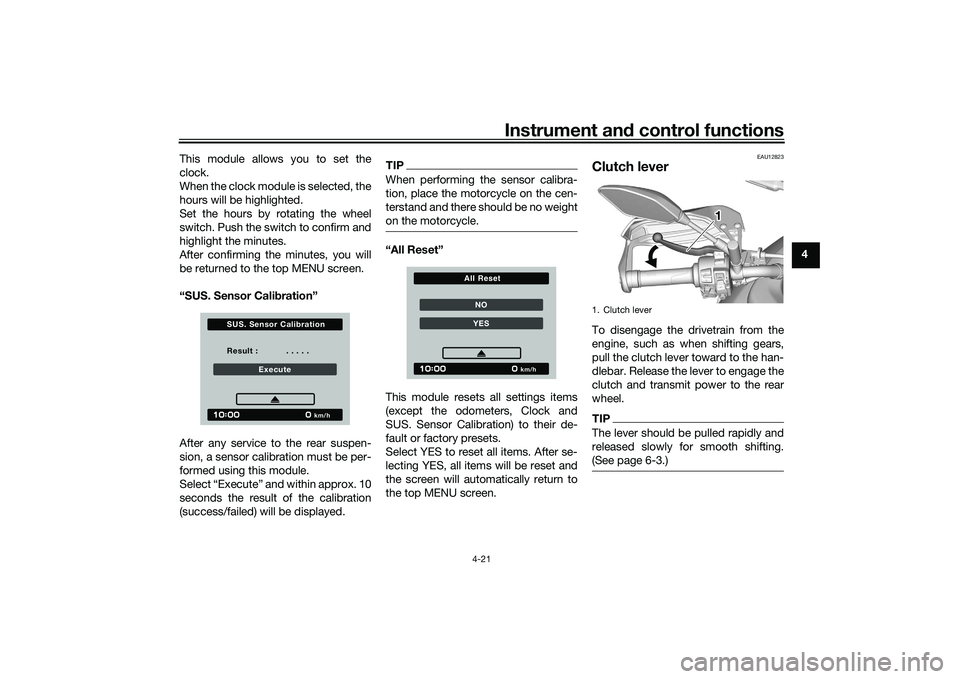
Instrument and control functions
4-21
4
This module allows you to set the
clock.
When the clock module is selected, the
hours will be highlighted.
Set the hours by rotating the wheel
switch. Push the switch to confirm and
highlight the minutes.
After confirming the minutes, you will
be returned to the top MENU screen.
“SUS. Sensor Cali
bration”
After any service to the rear suspen-
sion, a sensor calibration must be per-
formed using this module.
Select “Execute” and within approx. 10
seconds the result of the calibration
(success/failed) will be displayed.
TIPWhen performing the sensor calibra-
tion, place the motorcycle on the cen-
terstand and there should be no weight
on the motorcycle.“All Reset”
This module resets all settings items
(except the odometers, Clock and
SUS. Sensor Calibration) to their de-
fault or factory presets.
Select YES to reset all items. After se-
lecting YES, all items will be reset and
the screen will automatically return to
the top MENU screen.
EAU12823
Clutch leverTo disengage the drivetrain from the
engine, such as when shifting gears,
pull the clutch lever toward to the han-
dlebar. Release the lever to engage the
clutch and transmit power to the rear
wheel.TIPThe lever should be pulled rapidly and
released slowly for smooth shifting.
(See page 6-3.)
Result : . . . . .
Execute
km/h
S U S. S ensor Calibration
NOYES
km/h
All Reset
1. Clutch lever
111
UBAPE0E0.book Page 21 Thursday, December 24, 2020 9:14 AM
Page 113 of 116
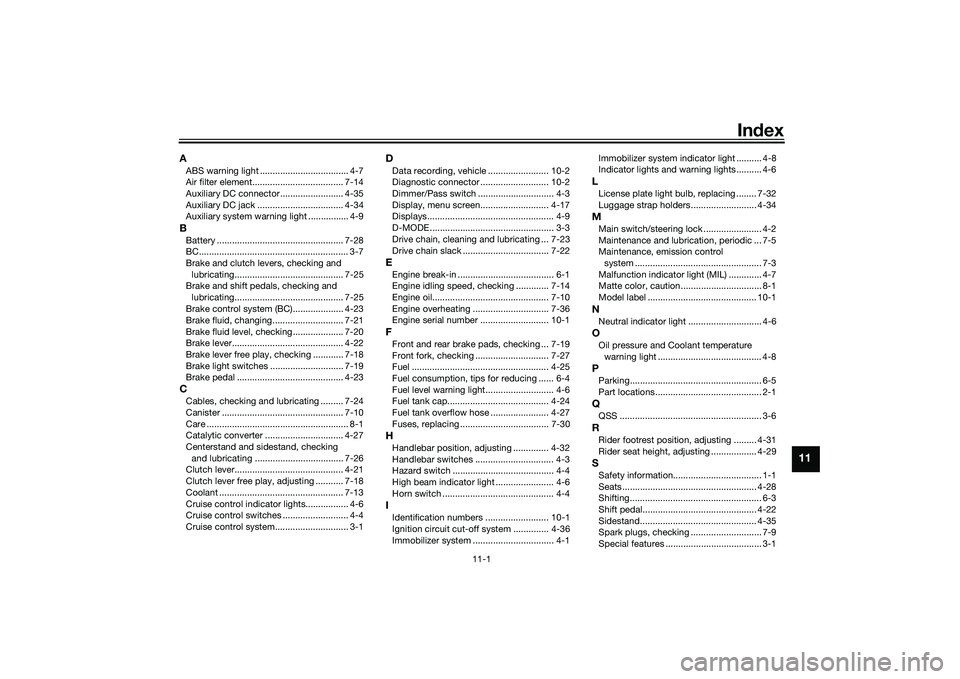
11-1
11
Index
AABS warning light ................................... 4-7
Air filter element.................................... 7-14
Auxiliary DC connector ......................... 4-35
Auxiliary DC jack .................................. 4-34
Auxiliary system warning light ................ 4-9BBattery .................................................. 7-28
BC........................................................... 3-7
Brake and clutch levers, checking and
lubricating........................................... 7-25
Brake and shift pedals, checking and
lubricating........................................... 7-25
Brake control system (BC).................... 4-23
Brake fluid, changing............................ 7-21
Brake fluid level, checking.................... 7-20
Brake lever............................................ 4-22
Brake lever free play, checking ............ 7-18
Brake light switches ............................. 7-19
Brake pedal .......................................... 4-23CCables, checking and lubricating ......... 7-24
Canister ................................................ 7-10
Care ........................................................ 8-1
Catalytic converter ............................... 4-27
Centerstand and sidestand, checking
and lubricating ................................... 7-26
Clutch lever........................................... 4-21
Clutch lever free play, adjusting ........... 7-18
Coolant ................................................. 7-13
Cruise control indicator lights................. 4-6
Cruise control switches .......................... 4-4
Cruise control system............................. 3-1
DData recording, vehicle ........................ 10-2
Diagnostic connector ........................... 10-2
Dimmer/Pass switch .............................. 4-3
Display, menu screen........................... 4-17
Displays.................................................. 4-9
D-MODE................................................. 3-3
Drive chain, cleaning and lubricating ... 7-23
Drive chain slack .................................. 7-22EEngine break-in ...................................... 6-1
Engine idling speed, checking ............. 7-14
Engine oil.............................................. 7-10
Engine overheating .............................. 7-36
Engine serial number ........................... 10-1FFront and rear brake pads, checking ... 7-19
Front fork, checking ............................. 7-27
Fuel ...................................................... 4-25
Fuel consumption, tips for reducing ...... 6-4
Fuel level warning light........................... 4-6
Fuel tank cap........................................ 4-24
Fuel tank overflow hose ....................... 4-27
Fuses, replacing ................................... 7-30HHandlebar position, adjusting .............. 4-32
Handlebar switches ............................... 4-3
Hazard switch ........................................ 4-4
High beam indicator light ....................... 4-6
Horn switch ............................................ 4-4IIdentification numbers ......................... 10-1
Ignition circuit cut-off system .............. 4-36
Immobilizer system ................................ 4-1 Immobilizer system indicator light .......... 4-8
Indicator lights and warning lights .......... 4-6
LLicense plate light bulb, replacing ........ 7-32
Luggage strap holders.......................... 4-34MMain switch/steering lock ....................... 4-2
Maintenance and lubrication, periodic ... 7-5
Maintenance, emission control
system .................................................. 7-3
Malfunction indicator light (MIL) ............. 4-7
Matte color, caution................................ 8-1
Model label ........................................... 10-1NNeutral indicator light ............................. 4-6OOil pressure and Coolant temperature warning light ......................................... 4-8PParking.................................................... 6-5
Part locations.......................................... 2-1QQSS ........................................................ 3-6RRider footrest position, adjusting ......... 4-31
Rider seat height, adjusting .................. 4-29SSafety information................................... 1-1
Seats ..................................................... 4-28
Shifting.................................................... 6-3
Shift pedal............................................. 4-22
Sidestand.............................................. 4-35
Spark plugs, checking ............................ 7-9
Special features ...................................... 3-1
UBAPE0E0.book Page 1 Thursday, December 24, 2020 9:14 AM